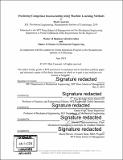| dc.contributor.advisor | Roy Welsch and Daniel Frey. | en_US |
| dc.contributor.author | Casavant, Matt(Matt Stephen) | en_US |
| dc.contributor.other | Sloan School of Management. | en_US |
| dc.contributor.other | Massachusetts Institute of Technology. Department of Mechanical Engineering. | en_US |
| dc.contributor.other | Leaders for Global Operations Program. | en_US |
| dc.date.accessioned | 2019-10-11T22:25:10Z | |
| dc.date.available | 2019-10-11T22:25:10Z | |
| dc.date.copyright | 2019 | en_US |
| dc.date.issued | 2019 | en_US |
| dc.date.issued | 2019 | en_US |
| dc.identifier.uri | https://hdl.handle.net/1721.1/122595 | |
| dc.description | Thesis: M.B.A., Massachusetts Institute of Technology, Sloan School of Management, 2019, In conjunction with the Leaders for Global Operations Program at MIT | en_US |
| dc.description | Thesis: S.M., Massachusetts Institute of Technology, Department of Mechanical Engineering, 2019, In conjunction with the Leaders for Global Operations Program at MIT | en_US |
| dc.description | Cataloged from PDF version of thesis. | en_US |
| dc.description | Includes bibliographical references (pages 59-60). | en_US |
| dc.description.abstract | Increasing competition in the defense industry risks contract margin degradation and increases the need for new avenues to margin expansion. One such area of opportunity is take-away bids for under-performing competitor sole source contracts. Post financial crisis, the government has been more willing to entertain conversation with outside firms about existing contracts in the execution phase if the contracted firm is under performing budgetary and schedule terms. The contracted firm has the opportunity to defend its performance though, so in order to maximize the likelihood of successful take-away, the bid would ideally be submitted when the contracted firm is distracted and cannot put together as strong of a defense as would be typical. Corporate restructuring is an example of such a time; employees are distracted and leadership, communication, and approval chains are disrupted. Because the government contracting process is long and detailed, often taking on the order of one year, if restructuring at competitor firms could be predicted up to a year in advance, resources could be shifted ahead of time to align bid submittal with the public restructuring announcement and therefore increase the likelihood of take-away success. The subject of this thesis is the development of the necessary dataset and application of various machine learning methods to predict future restructuring. Literature review emphasizes understanding of current methods benefits and shortcomings in relation to forecasting, and proposed methods seeks to fill in gaps. Depending on the competitor, the resulting models predict future restructuring on blind historical test set data with an accuracy of 80-90%. While blind historical test set data are not necessarily indicative of future data, one of the firm's under assessment recently announced a future restructuring in the same quarter that the model predicted. | en_US |
| dc.description.statementofresponsibility | by Matt Casavant. | en_US |
| dc.format.extent | 60 pages | en_US |
| dc.language.iso | eng | en_US |
| dc.publisher | Massachusetts Institute of Technology | en_US |
| dc.rights | MIT theses are protected by copyright. They may be viewed, downloaded, or printed from this source but further reproduction or distribution in any format is prohibited without written permission. | en_US |
| dc.rights.uri | http://dspace.mit.edu/handle/1721.1/7582 | en_US |
| dc.subject | Sloan School of Management. | en_US |
| dc.subject | Mechanical Engineering. | en_US |
| dc.subject | Leaders for Global Operations Program. | en_US |
| dc.title | Predicting competitor restructuring using machine learning methods | en_US |
| dc.type | Thesis | en_US |
| dc.description.degree | M.B.A. | en_US |
| dc.description.degree | S.M. | en_US |
| dc.contributor.department | Sloan School of Management | en_US |
| dc.contributor.department | Massachusetts Institute of Technology. Department of Mechanical Engineering | en_US |
| dc.contributor.department | Leaders for Global Operations Program | en_US |
| dc.identifier.oclc | 1119537667 | en_US |
| dc.description.collection | M.B.A. Massachusetts Institute of Technology, Sloan School of Management | en_US |
| dc.description.collection | S.M. Massachusetts Institute of Technology, Department of Mechanical Engineering | en_US |
| dspace.imported | 2019-10-11T22:25:10Z | en_US |
| mit.thesis.degree | Master | en_US |
| mit.thesis.department | Sloan | en_US |
| mit.thesis.department | MechE | en_US |
